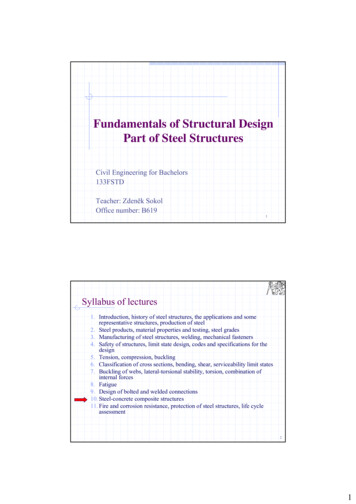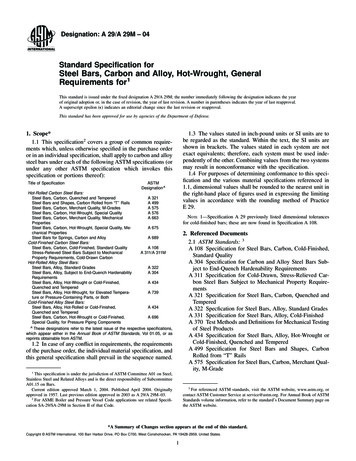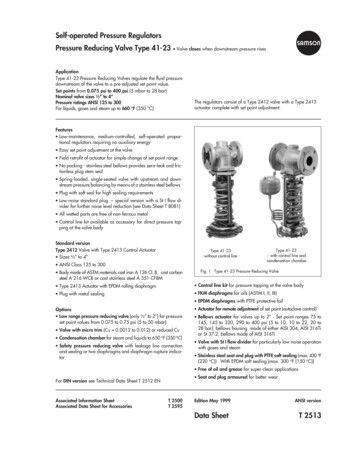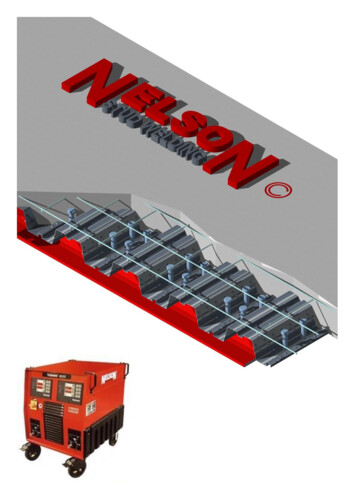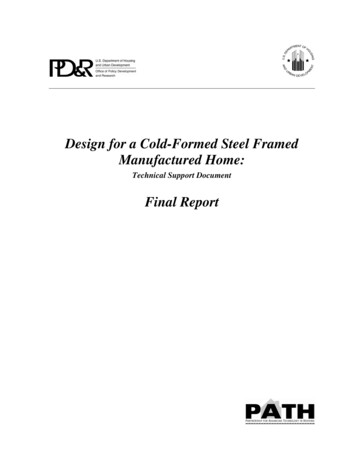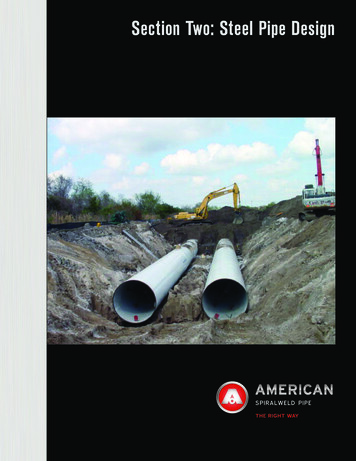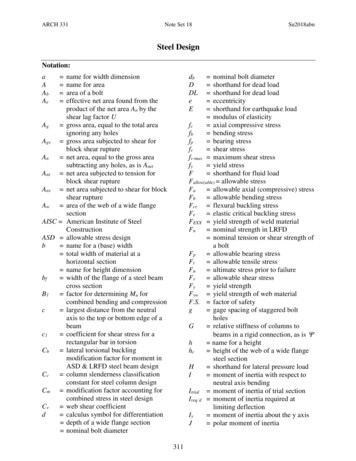
Transcription
ARCH 331Note Set 18Su2018abnSteel DesignNotation:aAAbAe name for width dimensionname for areaarea of a bolteffective net area found from theproduct of the net area An by theshear lag factor UAg gross area, equal to the total areaignoring any holesAgv gross area subjected to shear forblock shear ruptureAn net area, equal to the gross areasubtracting any holes, as is AnetAnt net area subjected to tension forblock shear ruptureAnv net area subjected to shear for blockshear ruptureAw area of the web of a wide flangesectionAISC American Institute of SteelConstructionASD allowable stress designb name for a (base) width total width of material at ahorizontal section name for height dimensionbf width of the flange of a steel beamcross sectionB1 factor for determining Mu forcombined bending and compressionc largest distance from the neutralaxis to the top or bottom edge of abeamc1 coefficient for shear stress for arectangular bar in torsionCb lateral torsional bucklingmodification factor for moment inASD & LRFD steel beam designCc column slenderness classificationconstant for steel column designCm modification factor accounting forcombined stress in steel designCv web shear coefficientd calculus symbol for differentiation depth of a wide flange section nominal bolt diameterdbDDLeEnominal bolt diametershorthand for dead loadshorthand for dead loadeccentricityshorthand for earthquake loadmodulus of elasticityfcaxial compressive stressfbbending stressfpbearing stressfvshear stressfv-maxmaximum shear stressfyyield stressFshorthand for fluid loadFallow(able) allowable stressFa allowable axial (compressive) stressFb allowable bending stressFcr flexural buckling stressFe elastic critical buckling stressFEXX yield strength of weld materialFn nominal strength in LRFD nominal tension or shear strength ofa boltFp allowable bearing stressFt allowable tensile stressFu ultimate stress prior to failureFv allowable shear stressFy yield strengthFyw yield strength of web materialF.S. factor of safetyg gage spacing of staggered boltholesG relative stiffness of columns tobeams in a rigid connection, as is h name for a heighthc height of the web of a wide flangesteel sectionH shorthand for lateral pressure loadI moment of inertia with respect toneutral axis bendingItrial moment of inertia of trial sectionIreq’d moment of inertia required atlimiting deflectionIy moment of inertia about the y axisJ polar moment of inertia311
ARCH 331Note Set 18k distance from outer face of Wflange to the web toe of fillet shape factor for plastic design ofsteel beamsK effective length factor for columns,as is kl name for length length of beam in rigid joint b length of column in rigid joint cL name for length or span length shorthand for live loadLb unbraced length of a steel beamLc clear distance between the edge of ahole and edge of next hole or edgeof the connected steel plate in thedirection of the load effective length of a steel member,as is eLc1 effective length in plane of bendingLr shorthand for live roof load maximum unbraced length of asteel beam in LRFD design forinelastic lateral-torsional bucklingLp maximum unbraced length of asteel beam in LRFD design for fullplastic flexural strengthL’ length of an angle in a connectorwith staggered holesLL shorthand for live loadLRFD load and resistance factor designM internal bending momentMa required bending moment (ASD)Mc allowable or design flexural strengthMn nominal flexure strength with thefull section at the yield stress forLRFD beam designMnt moment (ASD or LRFD) with thestructure restrained against lateraltranslationMmax maximum internal bending momentMmax-adj maximum bending momentadjusted to include self weightMp internal bending moment when allfibers in a cross section reach theyield stressMr required flexural strengthMu maximum moment from factoredloads for LRFD beam designMySu2018abninternal bending moment when theextreme fibers in a cross sectionreach the yield stressn number of boltsn.a. shorthand for neutral axisN bearing length on a wide flangesteel section bearing type connection withthreads included in shear planep bolt hole spacing (pitch)P name for load or axial force vectorPa allowable axial force required axial force (ASD)Pallowable allowable axial forcePc available axial strengthPe1 Euler buckling strengthPn nominal column load capacity inLRFD steel designPr required axial forcePu factored column load calculatedfrom load factors in LRFD steeldesignQ first moment area about a neutralaxis generic axial load quantity forLRFD designr radius of gyrationry radius of gyration with respect to ay-axisR generic load quantity (force, shear,moment, etc.) for LRFD design shorthand for rain or ice load radius of curvature of a deformedbeamRa required strength (ASD)Rn nominal value (capacity) to bemultiplied by in LRFD anddivided by the safety factor inASDRu factored design value for LRFDdesigns longitudinal center-to-centerspacing of any two consecutiveholesS shorthand for snow load section modulus allowable strength per length of aweld for a given size312
ARCH 331Note Set 18Sreq’d section modulus required atallowable stressSreq’d-adj section modulus required atallowable stress when moment isadjusted to include self weightSC slip critical bolted connectiont thickness of the connected materialtf thickness of flange of wide flangetw thickness of web of wide flangeT torque (axial moment) shorthand for thermal load throat size of a weldU shear lag factor for steel tensionmember designUbs reduction coefficient for blockshear ruptureV internal shear forceVa required shear (ASD)Vmax maximum internal shear forceVmax-adj maximum internal shear forceadjusted to include self weightVn nominal shear strength capacity forLRFD beam designVu maximum shear from factored loadsfor LRFD beam designw name for distributed loadwadjusted adjusted distributed load forequivalent live load deflection limitwequivalent the equivalent distributed loadderived from the maximum bendingmomentwself wt name for distributed load from selfweight of memberW shorthand for wind loadx horizontal distanceSu2018abnX bearing type connection withthreads excluded from the shearplaney vertical distanceZ plastic section modulus of a steelbeamZreq’d plastic section modulus requiredZx plastic section modulus of a steelbeam with respect to the x axis method factor for B1 equation actual actual beam deflection allowable allowable beam deflection limit allowable beam deflection limit max maximum beam deflection y yield strain (no units) resistance factor diameter symbol resistance factor for bending forLRFD resistance factor for compressionfor LRFD resistance factor for tension forLRFD resistance factor for shear forLRFD load factor in LRFD design b c t vSteel DesignStructural design standards for steel are establishedby the Manual of Steel Construction published by theAmerican Institute of Steel Construction, and usesAllowable Stress Design and Load and FactorResistance Design. With the 13th edition, bothmethods are combined in one volume which providescommon requirements for analyses and design andrequires the application of the same set ofspecifications.313pi (3.1415 radians or 180 )slope of the beam deflection curveradial distancesafety factor for ASDsymbol for integrationsummation symbol
ARCH 331Note Set 18Su2018abnMaterialsAmerican Society for Testing Materials (ASTM) is the organization responsible for material andother standards related to manufacturing. Materials meeting their standards are guaranteed tohave the published strength and material properties for a designation.A36 – carbon steel used for plates, anglesA572 – high strength low-alloy use for some beamsA913 – high strength low alloy use for some columns(grade 65 and grade 70)A992 – for building framing used for most beams(A572 Grade 50 has the same properties as A992)Ra ASDRnFy 36 ksi, Fu 58 ksi, E 29,000 ksiFy 60 ksi, Fu 75 ksi, E 29,000 ksiFy 65 ksi, Fu 80 ksi, E 29,000 ksiFy 70 ksi, Fu 90 ksi, E 29,000 ksiFy 50 ksi, Fu 65 ksi, E 29,000 ksi whereRa required strength (dead or live; force, moment or stress)Rn nominal strength specified for ASD safety factorFactors of Safety are applied to the limit stresses for allowable stress values:bending (braced, Lb Lp)bending (unbraced, Lp Lb and Lb Lr)shear (beams)shear (bolts)shear (welds)- 1.67 1.67 (nominal moment reduces) 1.5 or 1.67 2.00 (tabular nominal strength) 2.00Lb is the unbraced length between bracing points, laterallyLp is the limiting laterally unbraced length for the limit state of yieldingLr is the limiting laterally unbraced length for the limit state of inelastic lateral-torsionalbucklingLRFDwhere Ru i RiRu Rnwhere resistance factor load factor for the type of loadR load (dead or live; force, moment or stress)Ru factored load (moment or stress)Rn nominal load (ultimate capacity; force, moment or stress)Nominal strength is defined as thecapacity of a structure or component to resist the effects of loads, as determined by computationsusing specified material strengths (such as yield strength, Fy, or ultimate strength, Fu) anddimensions and formulas derived from accepted principles of structural mechanics or by field testsor laboratory tests of scaled models, allowing for modeling effects and differences betweenlaboratory and field conditions314
ARCH 331Note Set 18Su2018abnFactored Load CombinationsThe design strength, Rn , of each structural element or structural assembly must equal or exceedthe design strength based on the ASCE-7 (2010) combinations of factored nominal loads:1.4D1.2D 1.6L 0.5(Lr or S or R)1.2D 1.6(Lr or S or R) (L or 0.5W)1.2D 1.0W L 0.5(Lr or S or R)1.2D 1.0E L 0.2S0.9D 1.0W0.9D 1.0ECriteria for Design of BeamsMcI( M a M n / or M u b M n )Fb or Fn fb Allowable normal stress or normal stress from LRFD should not beexceeded:Knowing M and Fy, the minimum plastic section modulus fitting the limit is:Z req ' d Determining Maximum Bending Moment M Sreq ' d Fb MaFy Drawing V and M diagrams will show us the maximum values for design. Remember:V ( w)dxdVdM w VdxdxM (V )dxDetermining Maximum Bending StressFor a prismatic member (constant cross section), the maximum normal stress will occur at themaximum moment.For a non-prismatic member, the stress varies with the cross section AND the moment.DeflectionsIf the bending moment changes, M(x) across a beam of constant material and crosssection then the curvature will change:1 M ( x) REI slope 1M ( x)dxEI The slope of the n.a. of a beam, , will be tangent to the radius ofcurvature, R:The equation for deflection, y, along a beam is:315y 11 dx EIEI M ( x)dx
ARCH 331Note Set 18Su2018abnElastic curve equations can be found in handbooks, textbooks, design manuals, etc.Computerprograms can be used as well. Elastic curve equations can be superimposed ONLY if the stressesare in the elastic range.The deflected shape is roughly the same shape flipped as the bending moment diagram but isconstrained by supports and geometry.Allowable Deflection LimitsAll building codes and design codes limit deflection for beam types and damage that couldhappen based on service condition and severity.ymax ( x) actual allowable LUseLL onlyRoof beams:Industrial (no ceiling) L/180Commercialplaster ceilingL/240no plasterL/360Floor beams:Ordinary UsageL/360Roof or floor (damageable elements)valueDL LL*L/120L/180L/240L/240L/480* IBC 2012 states that DL for steel elements shall be taken as zeroLateral BucklingWith compression stresses in the top of a beam, a sudden “popping” or buckling can happeneven at low stresses. In order to prevent it, we need to brace it along the top, or laterally brace it,or provide a bigger Iy.Local Buckling in Steel Wide-flange Beams– Web Crippling or Flange BucklingConcentrated forces on a steel beam can cause the web to buckle (called web crippling). Webstiffeners under the beam loads and bearing plates at the supports reduce that tendency. Webstiffeners also prevent the web from shearing in plate girders.316
ARCH 331Note Set 18Su2018abnThe maximum support load and interior load can bedetermined from:Pn (max end) ( 2.5k N )Fyw t wPn (interior) ( 5k N )Fyw t wwheretw thickness of the webFyw yield strength of thewebN bearing lengthk dimension to fillet found in beam section tables 1.00 (LRFD) 1.50 (ASD)Beam Loads & Load TracingIn order to determine the loads on a beam (or girder, joist, column, frame, foundation.) we canstart at the top of a structure and determine the tributary area that a load acts over and the beamneeds to support. Loads come from material weights, people, and the environment. This area isassumed to be from half the distance to the next beam over to halfway to the next beam.The reactions must be supported by the next lower structural element ad infinitum, to the ground.LRFD - Bending or FlexureFor determining the flexural design strength, b M n , for resistance to pure bending (no axial load)in most flexural members where the following conditions exist, a single calculation will suffice: i Ri M u b M n 0.9 Fy ZwhereMu maximum moment from factored loads b resistance factor for bending 0.9Mn nominal moment (ultimate capacity)Fy yield strength of the steelZ plastic section modulusfPlastic Section Modulusfy 50ksiPlastic behavior is characterized by a yield point and anincrease in strain with no increase in stress.E1 y 0.001724317
ARCH 331Note Set 18Su2018abnInternal Moments and Plastic HingesPlastic hinges can develop when all of the material in a crosssection sees the yield stress. Because all the material at that sectioncan strain without any additional load, the member segments oneither side of the hinge can rotate, possibly causing instability.For a rectangular section:Elastic to fy:Ibh 2b 2c 2bc 2M y fy fy fy fyc663Fully Plastic:M ult or M p bc 2 f y 3 M y22For a non-rectangular section and internal equilibrium at y, then.a. will not necessarily be at the centroid. The n.a. occurs wherethe Atension Acompression. The reactions occur at the centroids of thetension and compression areas.Instability from Plastic HingesAtension AcompressionShape Factor:The ratio of the plastic moment to the elastic moment at yield:Mk pk 3/2 for a rectangleMyk 1.1 for an I beamPlastic Section ModulusMZ pandfyk ZS318
ARCH 331Note Set 18Su2018abnDesign for ShearVa Vn / or Vu vVnThe nominal shear strength is dependent on the cross section shape. Case 1: With a thick or stiffweb, the shear stress is resisted by the web of a wide flange shape (with the exception of ahandful of W’s). Case 2: When the web is not stiff for doubly symmetric shapes, singlysymmetric shapes (like channels) (excluding round high strength steel shapes), inelastic webbuckling occurs. When the web is very slender, elastic web buckling occurs, reducing thecapacity even more:Case 1) For h t w 2.24 EFyVn 0.6 Fyw Aw v 1.00 (LRFD) 1.50 (ASD)where h equals the clear distance between flanges less the fillet or cornerradius for rolled shapesVn nominal shear strengthFyw yield strength of the steel in the webAw twd area of the webCase 2) For h t w 2.24 EFyVn 0.6 Fyw AwCv v 0.9 (LRFD) 1.67 (ASD)where Cv is a reduction factor (1.0 or less by equation)Design for FlexureM a M n / or M u b M n b 0.90 (LRFD) 1.67 (ASD)The nominal flexural strength Mn is the lowest value obtained according to the limit states of1. yielding, limited at length L p 1.76ryE , where r is the radius of gyration in yyFy2. lateral-torsional buckling limited at length Lr3. flange local buckling4. web local bucklingBeam design charts show available moment, Mn/ and b M n , for unbraced length, Lb, of thecompression flange in one-foot increments from 1 to 50 ft. for values of the bending coefficientCb 1. For values of 1 Cb 2.3, the required flexural strength Mu can be reduced by dividingit by Cb. (Cb 1 when the bending moment at any point within an unbraced length is larger thanthat at both ends of the length. Cb of 1 is conservative and permitted to be used in any case.When the free end is unbraced in a cantilever or overhang, Cb 1. The full formula is providedbelow.)NOTE: the self weight is not included in determination of Mn/ and b M n319
ARCH 331Note Set 18Su2018abnCompact SectionsFor a laterally braced compact section (one for which the plastic moment can be reached beforelocal buckling) only the limit state of yielding is applicable. For unbraced compact beams andnon-compact tees and double angles, only the limit states of yielding and lateral-torsionalbuckling are applicable.Compact sections meet the following criteria:bf2t f 0.38EFyand hc 3.76 EtwFywhere:bf flange width in inchestf flange thickness in inchesE modulus of elasticity in ksiFy minimum yield stress in ksihc height of the web in inchestw web thickness in inchesWith lateral-torsional buckling the nominal flexural strength is Lb L p M pM n Cb M p ( M p 0.7 Fy S x ) L L p r where Mp Mn FyZxand Cb is a modification factor for non-uniform momentdiagrams where, when both ends of the beam segmentare braced:12.5M maxCb 2.5M max 3M A 4M B 3M CMmax absolute value of the maximum moment in theunbraced beam segmentMA absolute value of the moment at the quarter point of the unbraced beam segmentMB absolute value of the moment at the center point of the unbraced beam segmentMC absolute value of the moment at the three quarter point of the unbraced beamsegment length.Available Flexural Strength PlotsPlots of the available moment for the unbraced length for wide flange sections are useful to findsections to satisfy the design criteria of M a M n / or M u b M n . The maximum momentthat can be applied on a beam (taking self weight into account), Ma or Mu, can be plotted againstthe unbraced length, Lb. The limiting length, Lp (fully plastic), is indicated by a solid dot ( ),while the limiting length, Lr (for lateral torsional buckling), is indicated by an open dot ( ).Solid lines indicate the most economical, while dashed lines indicate there is a lighter sectionthat could be used. Cb, which is a lateral torsional buckling modification factor for non-zeromoments at the ends, is 1 for simply supported beams (0 moments at the ends). (see figure)320
ARCH 331Note Set 18Su2018abnDesign ProcedureThe intent is to find the most light weight member (which is economical) satisfying the sectionmodulus size.1. Determine the unbraced length to choose the limit state (yielding, lateral torsional bucklingor more extreme) and the factor of safety and limiting moments. Determine the material.2. Draw V & M, finding Vmax and Mmax.for unfactored loads (ASD, Va & Ma) or from factoredloads (LRFD, Vu & Mu)3. Calculate Zreq’d when yielding is the limit state. This step is equivalent to determining ifMMMMfb max Fb , Z req ' d max max (ASD) and Z req ' d u (LRFDFy b FyFbS to meet the design criteria thatM a M n / or M u b M nIf the limit state is something other than yielding,determine the nominal moment, Mn, or use plots ofavailable moment to unbraced length, Lb.4. For steel: use the section charts to find a trial Z andremember that the beam self weight (the second numberin the section designation) will increase Zreq’d. Thedesign charts show the lightest section within agrouping of similar Z’s.**** Determine the “updated” Vmax and Mmax including the beam self weight, and verify that theupdated Zreq’d has been met.******321
ARCH 331Note Set 18Su2018abn5. Consider lateral stability.6. Evaluate horizontal shear using Vmax. This step is equivalent to determining if f v Fv issatisfied to meet the design criteria that Va Vn / or Vu vVn3VVV 2 A Aweb t w dVQ IbFor I beams:f v max Others:f v maxVn 0.6 Fyw Awor Vn 0.6 Fyw Aw C v7. Provide adequate bearing area at supports. This step is equivalent to determining ifis satisfied to meet the design criteria that Pa Pn / or Pu Pn8. Evaluate shear due to torsionfp P FpAT Tf or F (circular section or rectangular)vvJc ab219. Evaluate the deflection to determine if maxLL LL allowed and/or maxTotal Total allowed**** note: when calculated limit, Ireq’d can be found with:and Zreq’d will be satisfied for similar self weight *****I req' d too bigI trial limitFOR ANY EVALUATION:Redesign (with a new section) at any point that a stress or serviceability criteria isNOT satisfied and re-evaluate each condition until it is satisfactory.Load Tables for Uniformly Loaded Joists & BeamsTables exist for the common loading situation of uniformly distributed load. The tables providethe safe distributed loads based on bending and deflection limits. For specific clear spans, theyprovide maximum total loads and live loads for a specific deflection limits.wequivalentL2M max If the load is not uniform, an equivalent uniform load can be calculated8from the maximum moment equation:If the deflection limit needed is not that of the table,the design live load must be adjusted. For example:Criteria for Design of ColumnsIf we know the loads, we can select a section that isadequate for strength & buckling.If we know the length, we can find the limiting loadsatisfying strength & buckling.322 L / 360 wadjusted wll have L / 400 table limitwanted
ARCH 331Note Set 18Su2018abnAllowable Stress DesignAmerican Institute of Steel Construction (AISC) Manual of ASD, 9th ed:Long and slender: [Le/r Cc, preferably 200]F12 2 EFallowable cr F .S . 23 Kl 2r The yield limit is idealized into a parabolic curve that blends into the Euler’s Formula at Cc.With Fy 36 ksi, Cc 126.1Cc With Fy 50 ksi, Cc 107.02 2 EFyShort and stubby: [Le/r Cc] Kl 2 r FyFa 1 2Cc2 F .S . with: KlKl5 3 rrF .S . 38C c8C c33Design for CompressionAmerican Institute of Steel Construction (AISC) Manual 15th ed:Pa Pn / or Pu c Pnwhere Pu i Pi is a load factorP is a load type is a resistance factorPn is the nominal load capacity (strength) 0.90 (LRFD) 1.67 (ASD)For compression Pn Fcr Agwhere :Ag is the cross section area and Fcr is the flexural buckling stress323
ARCH 331Note Set 18Su2018abnThe flexural buckling stress, Fcr, is determined as follows:Fwhen Lc 4.71 E (or y 2.25 ):FerFyFy Fcr 0.658 Fe Fy Fwhen Lc 4.71 E (or y 2.25 ):FerFyFcr 0.877FewhereFe is the elastic critical buckling stress:Lc is the effective lengthFe 2E Lc r 2Design AidsSample AISC Table for Available Strength in Axial CompressionTables exist for the value of the flexural buckling stress based on slenderness ratio. In addition,tables are provided in the AISC Manual for Available Strength in Axial Compression based onthe effective length with respect to least radius of gyration, ry. If the critical effective length isabout the largest radius of gyration, rx, it can be turned into an effective length about the y axisby dividing by the fraction rx/ry.324
ARCH 331Note Set 18Su2018abnProcedure for Analysis1. Calculate KL/r (Lc) for each axis (if necessary). The largest will govern the buckling load.2. Find Fa or Fcr as a function of KL/r from the appropriate equation (above) or table.3. Compute Pallowable Fa A or Pn Fcr Agor alternatively compute fc P/A or Pu/A4. Is the design satisfactory?Is P Pallowable (or Pa Pn/ ) or Pu cPn? yes, it is; no, it is no goodor Is fc Fa (or Fcr/ ) or cFcr? yes, it is; no, it is no goodProcedure for Design1. Guess a size by picking a section.2. Calculate KL/r (Lc) for each axis (if necessary). The largest will govern the buckling load.3. Find Fa or Fcr as a function of KL/r from appropriate equation (above) or table.4. Compute Pallowable Fa A or Pn Fcr Agor alternatively compute fc P/A or Pu/A5. Is the design satisfactory?Is P Pallowable (Pa Pn/ ) or Pu cPn? yes, it is; no, pick a bigger section and goback to step 2.Is fc Fa ( Fcr/ ) or cFcr? yes, it is; no, pick a bigger section and go back tostep 2.6. Check design efficiency by calculating percentage of stress used: Pa PP 100% 100% or u 100%PPallowable n c Pn If value is between 90-100%, it is efficient.If values is less than 90%, pick a smaller section and go back to step 2.Columns with Bending (Beam-Columns)In order to design an adequate section for allowable stress, we have to start somewhere:1. Make assumptions about the limiting stress from:- buckling- axial stress- combined stress2. See if we can find values for r or A or Z.3. Pick a trial section based on if we think r or A is going to govern the section size.325
ARCH 331Note Set 18Su2018abn4. Analyze the stresses and compare to allowable using the allowable stress method orinteraction formula for eccentric columns.5. Did the section pass the stress test?- If not, do you increase r or A or Z?- If so, is the difference really big so that you could decrease r or A or Z to make itmore efficient (economical)?6. Change the section choice and go back to step 4. Repeat until the section meets thestress criteria.Design for Combined Compression and Flexure:The interaction of compression and bending are included in the form for two conditions based onthe size of the required axial force to the available axial strength. This is notated as Pr (either Pafrom ASD or Pu from LRFD) for the axial force being supported, and Pc (either Pn/ for ASDor cPn for LRFD).The increased bending moment due to the P- effect must be determined and used as themoment to resist, where Mr B1Mnt with B1 defined below and Mnt is the moment using ASD orLRFD load combinations with the structure restrained against lateral translation.ForPr 0.2 :PcPr 8 M rx M ry 1.0Pc 9 M cx M cy ForM PrP M 0.2 : r rx ry 1.0Pc M cx M cy Pcwhere:for compression c 0.90 (LRFD)for bending b 0.90 (LRFD)Mr required flexural strengthMc allowable or design flexural strength 1.67 (ASD) 1.67 (ASD)Cm 1.0For a braced condition, the moment magnification factor B1 is determined by B1 1 ( Pu Pe1 )where Cm is a modification factor accounting for end conditionsWhen not subject to transverse loading between supports in plane of bending: 0.6 – 0.4 (M1/M2) 1.0, where M1 and M2 are the end moments and M1 M2.M1/M2 is positive when the member is bent in reverse curvature (moments thesame direction), negative when bent in single curvature.When there is transverse loading between the two ends of a member: 0.85, members with restrained (fixed) ends 2 EI 1.00, members with unrestrained ends 1.00 (LRFD); 1.60 (ASD)Pe1 Euler buckling strengthLc1 effective length in the plane of bending326Pe1 Lc1 2
ARCH 331Note Set 18Su2018abnDesign AidsSample AISC Table for Available Strength - CombinedTables are provided in the AISC Manual, 15th ed. for Available Strength for Members Subject toAxial, Shear, Flexural and Combined forces based on the effective length for compression andunbraced length for bending.Criteria for Design of ConnectionsConnections must be able to transfer any axial force, shear, or moment from member to memberor from beam to column.Connections for steel are typically high strength bolts and electric arc welds. Recommendedpractice for ease of construction is to specified shop welding and field bolting.327
ARCH 331Note Set 18Su2018abnBolted and Welded ConnectionsThe limit state for connections depends on the loads:1. tension yielding2. shear yielding3. bearing yielding4. bending yielding due to eccentric loads5. ruptureWelds must resist shear stress. The designstrengths depend on the weld materials.Bolted Connection DesignBolt designations signify material and type of connection whereSC: slip criticalN: bearing-type connection with bolt threads included in shear planeX: bearing-type connection with bolt threads excluded from shear planeA307: similar in strength to A36 steel (also known as ordinary, common or unfinishedbolts)ASTM F3125 Grade A325: high strength bolts (Group A)ASTM F3125 Grade A490: high strength bolts (higher than A325) (Group B)ASTM F3043 and ASTM F3111 (Group C)Bearing-type connection: no frictional resistance in the contact surfaces is assumed andslip between members occurs as the load is applied. (Load transfer through boltonly).Slip-critical connections: bolts are torqued to a high tensile stress in the shank, resultingin a clamping force on the connected parts. (Shear resisted by clamping force).Requires inspections and is useful for structures seeing dynamic or fatigue loading.Class A indicates the faying (contact) surfaces are clean mill scale or adequate paintsystem, while Class B indicates blast cleaning or paint for 0.50.Bolts rarely fail in bearing. The material with the hole will more likely yield first.For the determination of the net area of a bolt hole the width is taken as 1/16” greater than thenominal dimension of the hole. Standard diameters for bolt holes are 1/16” larger than the boltdiameter. (This means the net width will be 1/8” larger than the bolt.)Design for Bolts in Bearing, Shear and TensionAvailable shear values are given by bolt type, diameter, and loading (Single or Double shear) inAISC manual tables. Available shear value for slip-critical connections are given for limit statesof serviceability or strength by bolt type, hole type (standard, short-slotted, long-slotted or328
ARCH 331Note Set 18Su2018abnoversized), diameter, and loading. Available tension values are given by bolt type and diameterin AISC manual tables. The values are provide per
Steel Design Structural design standards for steel are established by the Manual of Steel Construction published by the American Institute of Steel Construction, and uses Allowable Stress Design and Load and Factor Resistance Design. With the 13th editio



